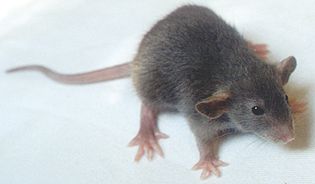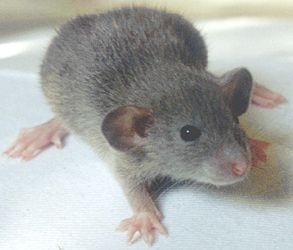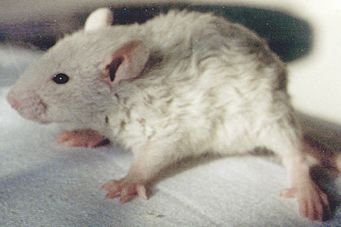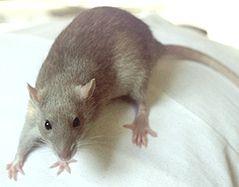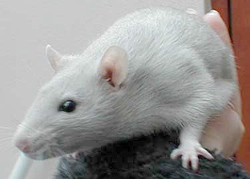|
Origins Geri Hauser bred these rats together and found they produced dark grey kittens, of a shade which closely resembled blue mice, cats and dogs. It was originally called "Mouse Blue" but this was changed to Russian Blue in honour of its resemblance to the similarly-coloured cat breed. The first was shown in 1994, and was standardised by the AFRMA in early 1996. Russians were exported to
breeders in Sweden, Germany, Holland and Belgium, and it is
from there that they came to the UK. Sue Brown brought the
first Russian Blues over in May 2000, two bucks from Holland
sired by a Russian Blue from Sweden, and a brother-sister
pair from a breeder in Germany arranged by Ann Storey, who
took one of the bucks from Holland and the male of the
German pair. Later in the year, Sue was also given a Russian
Blue agouti Rex Dumbo by a breeder in Belgium, who was bred
to one of the bucks to produce the first Russian litter in
the UK in October 2000. |
 RUSSIAN BLUE DOE, Mercedes First Russian Blue female in UK. |
|
Russian Blue Standards UK The standard currently in use by all UK clubs asks for a soft medium grey-blue with a metallic sheen, similar to blue cats and dogs. Faint light speckling or a subtle ticked effect is usual for the variety, and not to be considered a fault. USA The AFRMA was the first club to standardise Russian Blues, and calls for a color similar to blue mice or blue cats, a very dark slate blue color with dark ticking throughout and black eyes. The RMCA describes it as like the Russian Blue cat; very dark slate blue with dark ticking throughout. RMFE 's standard
requires a very dark blue-grey, like steel, with a slightly
heathered look due to pigment clumping in the hair shaft and
compares the colour to "blue" greyhound dogs or mice, and
Russian blue in cats.
|
RUSSIAN
BLUE DUMBO KITTEN, |
|
Genetics of the Russian Blue Russian Blue seems to be a simple, straightforward recessive gene which behaves as Blue dilution in dogs, cats and other animals. There appears to be no great variation of shade between littermates, although some may be a little lighter than the preferred dark colour, and these often also show a brownish tinge, which is a fault. Russian Blue is not related to any of the other types of Blue rat (as mentioned above), and the two kinds are clearly distinct when seen side by side. A Russian Blue (not carrying any other colours) bred to a Blue (not carrying any other colours) will produce only black kittens. Genetic
nomenclature has been adopted in different forms in
different countries. In the UK, where the existing
Blue has already been designated d (see the section about Blue
genetics here),
Russian is likely to become known as rb to avoid confusion. |
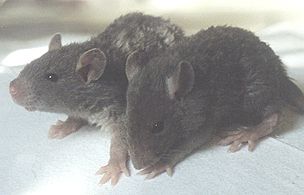
RUSSIAN BLUE REX KITTENS. |
|
Russian Blue Colours Russian Blue can be combined with other rat colours and genes to give a wealth of new varieties, some of which are extremely attractive. Silver Blue also known
as Russian Silver The rats of this colour which have been bred in the UK don't appear to resemble a blue version of silver mink. Rather, they are a clear, bright self silver with black eyes, described by one owner as "aluminium" coloured. It is quite different from Platinum, and most resembles a self Silver mouse with a delicate blue tint (though in mice this colour has red eyes). In the UK the word "Silver" has traditionally been used to describe animals which are "silvered" i.e. having ticking of white hairs all over, as in Silver/ed Mink rats, and the name Silver Blue is already in use for a standard Blue rat with silvering. For this reason, the "double blue" combination of Russian and Standard Blue will be known as Russian Silver. Russian Blue Agouti Russian Mink &
Russian Cinnamon Russian combined with Mock Mink creates a pretty dove grey colour, not unlike the colour standardised as Lilac in the UK, but much darker than Lilac and lacking its distinct pink tone. Russian Mock Cinnamon (Russian combined with Agouti and Mock Mink) is a warm rich fawn ticked with dove, and as may be expected, also bears resemblance to UK Lilac Agouti, but is darker. A colour is bred by AFRMA breeders called Dove, which is described as a blue-chocolate colour similar to Dove mice, but it appears unclear as to whether this is a combination of Chocolate and Russian, Mink and Russian, or the mystery Mock Mink and Russian. Blue-Beige also known
as Russian Platinum Silver Dove Russian Blue point Siamese Russian Platinum (UK) Other Russian dilutions |
OWNED BY ESTELLE SANDFORD. |
